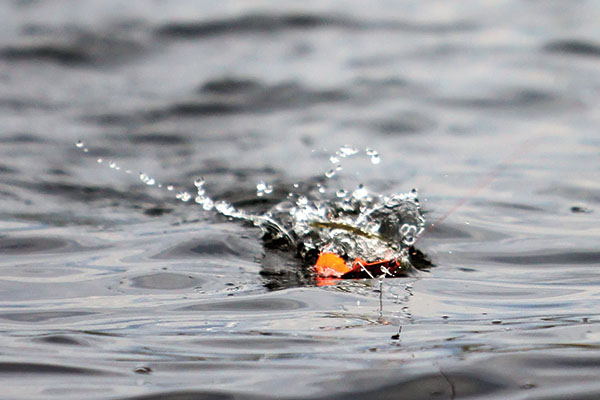
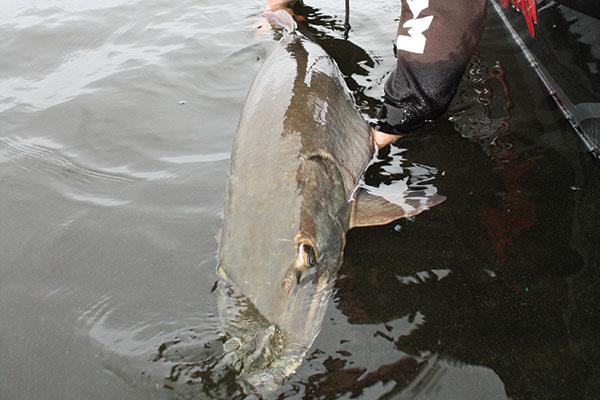 Few things in fishing are more exciting than watching a muskie suddenly appear like a great white shark stalking your surface lure. It’s even more heart-stopping when the monster opens its mouth and engulfs it. Unfortunately, many muskie anglers are of the mistaken belief that, while thrilling to use, topwater lures are low-percentage options and highly situational.
Few things in fishing are more exciting than watching a muskie suddenly appear like a great white shark stalking your surface lure. It’s even more heart-stopping when the monster opens its mouth and engulfs it. Unfortunately, many muskie anglers are of the mistaken belief that, while thrilling to use, topwater lures are low-percentage options and highly situational.
Not so, says renowned Ottawa River muskie guide John Anderson, legendary muskie guru Dick Pearson, and Lake of the Woods muskie stalker Darcy Cox. There’s almost never a time, nor a situation, when the trio won’t throw a surface bait. It’s why they’re topwater trendsetters.
“If an angler only threw surface baits, they would catch fewer fish, but they would be much bigger,” says Anderson, who owns the Ottawa River Muskie Factory. Pearson, on the other hand, has seen it all during his time on the water, pioneering muskie tactics through the heydays of the 1970s, 80s, and 90s. He attributes much of today’s topwater skepticism to times past, when lure selection was limited and hooking percentage poor.
“Many in my era tried it, but quit,” Pearson says. “I can remember having multiple blow-ups and losing fish after fish on early versions of the Mud Puppy and Arbogast Muskie Jitterbug. Today, however, I haven’t found a surface bait I don’t like. The variety is amazing.”
Cox, ironically, fell head over heels for surface lures, taking the fast lane to the top of the water column after reading an article penned by Pearson in In-Fisherman magazine. “It opened my eyes as to how versatile topwater lures can be for muskies,” says Cox, whose Tank Industry Guide Service has a waiting list of guests. “I was throwing Globes in 2-foot waves and using prop baits and walk-the-dog-style surface lures in sunny conditions, which is counter to what we’re taught. I think the word is getting out now, as more muskie anglers are discovering how deadly surface baits can be.”
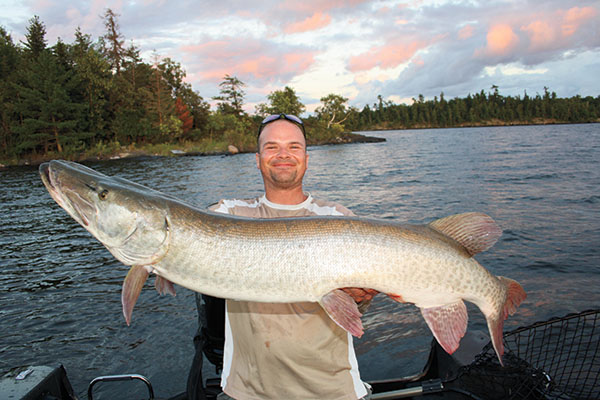 THE ULTIMATE EDGE
THE ULTIMATE EDGE
“My transition to taking muskies on topwater was gradual,” recalls Pearson, who’s also an avid hunter. “I began looking at muskies the same way I look at whitetail deer — as creatures of edges. That’s when the importance of the surface became more apparent. I regard it now as the ultimate edge. The place where two worlds collide. The place where oxygen, temperature, wind, sound, and visibility have their greatest variations and consequences.
“There were eureka moments, as well,” he says. “The first evening I ever threw a Top Raider, for instance, I boated four nice fish. Another time, in the 1980s, I threw the first Jackpots in rollers on Lac Seul and boated five big muskies in one day.” While Anderson, Pearson, and Cox won’t hesitate to present a surface bait around any piece of structure or cover, or in any weather or water conditions, they concede that they’ve isolated a range of locations and conditions where the lures excel.
“Project Noble Beast is my bible,” Anderson says, referring to Sean Landsman’s groundbreaking telemetry research on the Ottawa River. “It showed how devoted muskies are throughout the season to specific shallow structures like rocky shoals and dense weedbeds. When you understand how dedicated the fish are to specific locations, you realize why you need to enter waypoints on every spot you raise a big fish.
“You can make a living casting topwaters at sunset. I use them in the morning, as well, but the evening is universally more productive, especially in July and August. Throwing topwaters at sunset in mid-summer is a great big-fish strategy,” he says.
Spotting shallow cover, especially associated with vegetation, also persuades Cox to drop whatever rod he’s holding and quickly grab one rigged with a topwater lure. “I’ve found that surface baits work well on sunny, warm days immediately following a cold front,” he says. “I often find muskies in as little as 6 inches of water during the warm-up. They don’t want to go out deep to chase food.
“The first couple of weeks after the muskie season opens is a great time to use topwaters. Fish are shallow, soaking up the heat, so a topwater is the perfect lure to use where the fish feel most comfortable.” Pearson agrees. “In summer, calm, warm mornings and evenings are best around shallow structures with submergent vegetation and reeds,” he says.
“But topwaters are often my bait of choice on Opening Day, as well. Warming water is much better, in my opinion, than cooling water.”
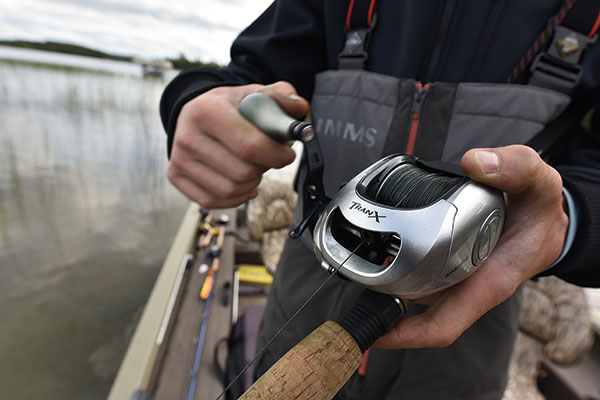 GOOD VIBRATIONS
GOOD VIBRATIONS
Listen to Anderson, Pearson, and Cox talk about topwaters and you frequently hear about noise, vibration, and water displacement. “Part of the collision factor I mentioned earlier,” Pearson says, “are noise and visual disturbance. It’s like an escaping mouse triggering a cat. Sound is very important. You’re tickling their lateral lines with good vibrations.
“The deep pop produced by a Fat Bastard in the wind may be key one time, while a light pop, or as I like to say, the pitter-patter of little feet, works better another time. In a walk-the-dog-style bait, a Jackpot may work, but then the whoosh of a Weagle outfishes it. Similarly, I’ve seen times when tinkling a flaptail is unbeatable and then, for no reason, the waddling plop-plop of a Creeper shines. You have to think about the different sound options and vary them regularly.”
While Cox also pays attention to the different sounds surface baits make, he’s even more fixated on their vibrations, likening the pulse patterns to the big double-bladed bucktails that have taken the muskie world by storm. “The bigger the vibration radius, the more muskies you can call in with a surface bait,” Cox says. “That’s why #10 bucktails changed the game. Nothing matches their ‘call radius.’ It’s the same with topwater baits.
“Sometimes, however, a call radius isn’t required. If you’re casting to a spot where you know a muskie is positioned, the silent treatment may entice a fish that’s wary of the unnatural clatter from rattles. That’s why I tend to throw noisy topwaters when I’m searching for muskies, switching to quieter surface baits when I return to a fish I raised earlier, or when working high-percentage water.”
Anderson, on the other hand, believes that fish in general, and muskies in particular, pattern sound more easily than they do sight. And he’s convinced it extends beyond the timbre or tone of your lure, to include things like your electric trolling motor and sonar.
“I was involved in a sturgeon tagging study on the St. Lawrence River, and we couldn’t approach a tagged fish when the water pump was running,” Anderson says. “It wasn’t noisy, but it had a distinct resonance that the biologist in charge of the study said the fish had learned to identify. As soon as we turned off the pump, we could drive right up to them.”
After being involved in that project and studying how muskies react to various surface sounds, Anderson is convinced that they’ve become conditioned to avoid many popular lures. “I’m throwing much bigger surface lures these days,” he says. “Lures like the Big Mama, Dirdy B, and Twisted Sis’tr offer a larger visual profile, but beyond that, they make a different noise and throw more water. The Top Raider is a great lure, but most muskies have seen and heard it so many times I’m certain they’ve learned to avoid it.”
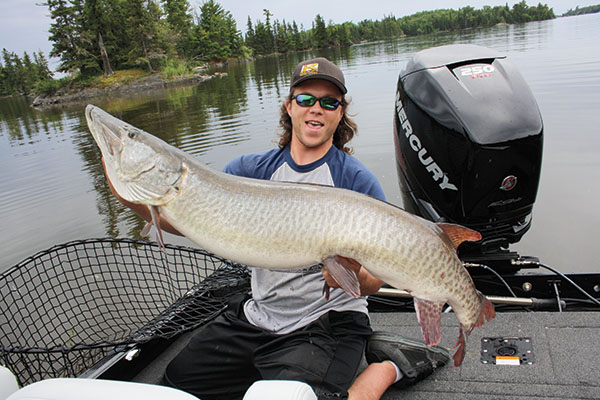 FAST & ERRATIC OR SLOW & STRAIGHT?
FAST & ERRATIC OR SLOW & STRAIGHT?
This also applies to walker-style lures. Anderson says you typically raise more fish with lures that sashay back and forth erratically, but you put more in the boat with baits that run straight ahead. “Muskies don’t miss topwater lures by mistake,” he says. “It’s never an accident. So, if you’re seeing fish, or having them boil on your bait, it’s because you’re doing something they don’t want you to do. Usually it’s the speed of your retrieve.
“Most muskie anglers have two retrieve speeds: fast and really fast. I have so many people in the boat with me each season that I get to study them carefully. It has taught me that retrieving surface baits slowly is essential most of the time. I typically crawl them along, retrieving them ever slower, certainly slower than other lure types.”
While Cox differs slightly from Anderson in his fondness for walk-the-dog style topwaters, he agrees that a lingering retrieve is almost always better than a rapid one. “Walk-the-dog-style topwaters are slow-moving lures,” Cox says. “You want to make them act wounded. They’re in the right position above the fishes’ heads so they can see them from different depths and directions. A lazy muskie can cruise up, slowly make the decision to eat, then attack with minimal effort and a high chance of success.”
GO FIGURE
No lure is perfect, and while surface baits come with little baggage, they’re not without warts. The biggest is when you spot a muskie trailing your lure. Surface lures are the most difficult to work at the side of the boat when you’re trying to entice a reluctant fish to bite.
“If I spot a muskie following my surface bait, I try to duck down and hide,” Pearson says. “I change the retrieve speed if time permits. I also move my rod tip and try to change the lure’s direction. But usually you’re faced with two choices: Either stop the lure in its tracks, or take it under and go into a figure-eight or circle.
“Stopping works, although most muskie anglers are hesitant to try it. I have film of me catching a 50-inch fish after stopping a walk-the-dog style topwater. You can see the fish rise up slowly and take it down like a bobber. If I go into a figure-eight, however, I almost always pull the topwater under, hoping that I can continue its action and in doing so, create a trail of bubbles.”
TOPWATER ACES UP THEIR SLEEVES
Being smitten with surface baits means Anderson, Pearson, and Cox have their fair share of aces up their sleeves. Pearson, for example, likes walker-style lures over deep water whenever he spots suspended balls of bait, especially ciscoes, in the upper part of the water column. And he won’t hesitate to fish these lures in rollers when a storm is approaching.
Anderson, however, rarely leads with a surface bait, typically starting each day with muskie-size jerkbait, glidebait, softbait, or bladebait. “But if I can’t seal the deal, I use a surface lure,” he says. “They’re the best clean-up bait you can tie on.”
Cox likes to fish the most unlikely spots, a foot or less of clear water, at the most dubious time, mid-day, under bright sun. “On opening day last year, I was sight-fishing on a sandflat in one foot of water when I spotted a gorgeous muskie,” he says. “My guest made a cast and the wake was Godzilla-like. The strike on the figure-eight was classic, and the ensuing fight a masterpiece. The fish measured 51.5 inches and we watched the whole show, from start to finish, on a flat-calm, blue-sky, sunny day. You have to love throwing surface baits for muskies.”
*In-Fisherman Field Editor Gord Pyzer is a former Ontario natural resource manager and National Fresh Water Fishing Hall of Fame inductee. He lives in Kenora, Ontario.








































